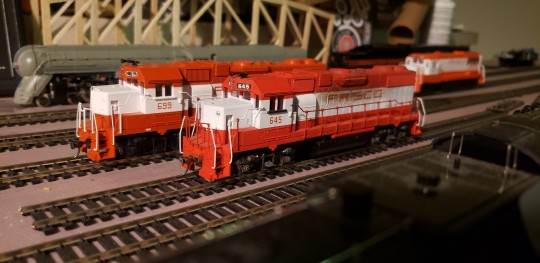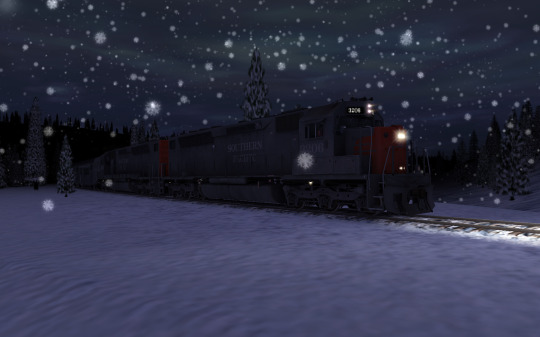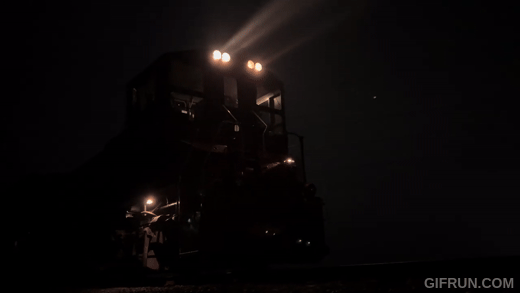#gyralight
Video
youtube
SW1500 North Western Pacific 1501. The oscillating Gyralite is part of the trademark Southern Pacific headlight package. Here, it lights up the underside of Highway 37 in Ignacio, California (South Novato) as train NWP 1501 North merges onto the double track Sonoma-Marin Area Rail Transit (SMART) corridor (if I interpolate the location accurately) -- a practice that to me shows any light rail company could do industrial traffic, if they wanted to actually get trucks off of roads.
1 note
·
View note
Text



Expanded the fleet over the past week. My Rapido U25B (803) arrived Saturday, and today a Kato U25B (815), GP38AC (645), and GP35 (726) arrived.
SLSF 815 needs a decoder before I can do a good cross comparison between Bowser/Stewart (825), Rapido, and Kato builds. SLSF 699 needs a whole install, plus both GP38s need Gyralights added. SLSF 724 needs a replacement decoder and detailing on the nose fixed.
I already have enough dcc equipped units to complete one of Frisco's absurd lashups, but it'll be great to have the 4 pack of GP units running together once they're all done.
#model railroading#model trains#model railroad#frisco#ho scale#u25b#rapido trains#bowser trains#Kato trains#athearn#athearn trains#Bachmann trains#emd#general electric
1 note
·
View note
Photo

Day 23: EMD SDP45
Info from Wikipedia
The SDP45 is a six-axle, C-C, 3,600-horsepower (2,680 kW) diesel-electric locomotive built by General Motors' Electro-Motive Division of La Grange, Illinois. It was a passenger-hauling version of the SD45 on a stretched locomotive frame with an extended, squared-off long hood at the rear, aft of the radiators, giving space for a steam generator for passenger train heating. This steam generator placement followed the pattern set by the SDP35 and SDP40. The Southern Pacific Railroad ordered their ten on May 9, 1966 with the units being placed in service between May 24 and July 26, 1967, initially on the City of San Francisco between Oakland and Ogden, and eventually used system-wide. As built, each unit carried 2,500 US gallons (9,500 l; 2,100 imp gal) of fuel and 3,000 US gallons (11,000 l; 2,500 imp gal) of steam generator water in a partitioned underframe tank. The steam generator was a Vapor Model OK-4740. SP's units had Pyle National Gyralights on the leading end, came with Nathan P-3 horns, and cost $317,156 each (SP's straight SD45's from the same period cost $290,788 each). Ordered with 62:15 gearing with the overspeed set at 72 mph (116 km/h), the gearing was changed to 60:17 (overspeed at 83 mph or 134 km/h) during 1968–1969. All except 3201 and 3207 would eventually be re-geared back to 62:15 once they entered commuter service. After Amtrak took over long-distance routes in 1971, various units were leased to Amtrak for West Coast service (primarily on the Coast Starlight) until Amtrak purchased their SDP40F locomotives, while the rest were used in freight service and on Company specials. Beginning in 1973 the SDP45s were used for commuter service on the San Francisco Peninsula Commute, replacing the Fairbanks-Morse Train Masters. SP's commuter service was demanding work and the locomotives required electrical modification to meet those demands. A "Passenger Start" switch was installed inside the cab electrical cabinet; in the "COMM" position the units were held in Parallel, in the "FRT/PASS" position normal transition was made. They stayed on the commute route (often working in freight service on weekends) until 1985 when Caltrain equipment arrived, and they were placed into freight service until their retirement, initially working out of Roseville, then in local and hauler service in the Los Angeles Basin. All were retired between 1986 (3208) and 1990 (3204) and sold for scrap. The Great Northern Railway purchased eight SDP45s in 1967 to replace F-units on the Empire Builder. Normally paired back-to-back, they were also used singly leading F-units. These joined six smaller SDP40 locomotives ordered in 1966 for the Western Star. After the startup of Amtrak in 1971, Great Northern Railway successor Burlington Northern Railroad converted all fourteen SDP locomotives to freight service. The Erie Lackawanna Railroad ordered 14 SD45Ms in 1969 and 1970. Intended for freight service, these units had standard (angled) long hood ends, the extra space aft of the radiators had concrete ballast. Their longer frames permitted a larger fuel tank which gave the locomotives a greater range between fuel stops. One Burlington Northern Railroad SDP45 (photo of BN 6599, closeup of HT-BB truck) was retrofitted with an articulated four-axle truck by EMD in 1983-84, converting it to an A1A-B+B wheel arrangement. The middle traction motor in the lead truck was removed and placed in the rear truck. The rear truck, called the HT-BB, for High Traction B+B arrangement, was tested successfully but advances in traction motors obviated the need for four axle trucks. This testing was not related to the development of the HTCR three-axle radial truck first seen under EMD SD60s and SD60MACs, and made standard on the early SD70 series. Southern Pacific Railroad 8691-8696 were SD40M-3 rebuilds done by Morrison-Knudsen. They were ex-EL 3654, 3668, 3666, 3665, 3662 and 3659. It is this group that most surviving SDP45s belong to. Erie Lackawanna Railroad 3639, later Conrail 6670, was listed as being preserved at the Virginia Museum of Transportation, although the museum's collection list does not show it. In August 2018, Youngstown Steel Heritage announced their intention to purchase 3639 and move it to their museum, with the goal of restoring it to operating condition, and eventually back to its original number and paint scheme. In September 2018, the group announced that they had successfully purchased the locomotive.
Models and Route by: Jointed Rail, Trainz-Forge, Auran, and Download Station
2 notes
·
View notes
Photo

"The Last Shot" This shot isn't particularly good, but it's significant to me. It was taken late in the day (light-wise) at Crosby, KY, on the Cumberland Valley Subdivision, on Wednesday, December 8, 1982. David DeVault and I had spent much of the day (we both took a vacation day from work to just "get out") in and around Corbin. We visited with division personnel there, and knocked around the yard and took photos before we headed for home via Loyall and Harlan instead of Cumberland Gap. We knew this train was en route northward to Corbin, but we weren't sure where we could get it. Just east of Blackmont, we saw him through the trees, on the other side of the river. I quickly saw the shadows had lengthened too far at my first choice for a shot---an overhead bridge at Blackmont---so we drove further and dived down a secondary road (one-lane in places) to this spot---Crosby. Just behind us is TeJay, and the current-day load out at Balkan is a little further around the next curve (again behind us). It was really getting dark by now, so I knew we wouldn't have much luck in getting a shot unless he was going slow---which he wasn't when we first saw him. I told Dave there was a chance he would be on a slow order as he passed us, because it was obvious some track work was underway. Sure enough, he came around the curve creeping along at about 10 to 15 MPH. I made some quick adjustments to the aperture and shutter speed to do the best I could. So, why was this the "last shot." It turned out to be my very last slide (or negative) of a train operated by the Louisville & Nashville Railroad Company. In three weeks the L&N would die as a corporation, its assets consumed into the new Seaboard System. I thought the visible changes would be slow in coming, but the new company did everything they could to obliterate "L&N" on cars, bridges, and particularly locomotives. L&N CV Sub Extra 3580 North--with the lead unit's rotating Gyralight caught at the moment it glared almost directly into my camera--was the last I would place on film. All these years later, I'm glad we backtracked to get this shot. It wasn't anything special, except to me. Ron Flanary
3 notes
·
View notes
Text

youtube
1 note
·
View note
Photo

The Southern Pacific #1518 at the Illinois Railway Museum in Union, IL. on 02-03-2010. by extra156west on Flickr.
Via Flickr:
Southern Pacific Railroad’s (SP) number 1518 is an EMD SD7 diesel locomotive. It was built originally in May 1951 as General Motors Electro-Motive Division’s (EMD) Demonstrator #990. It was the first “SD” series locomotive ever built.[1] Its road number 990 is in reference to its EMD Engineering Department Project Number: 15990. It demonstrated on several roads before being sold to Southern Pacific on 10/10/52 and sent back to EMD for refurbishing and repainting in SP’s tiger stripe paint and renumbering as #5308. It was classified in one-unit class DF-116 as it was slightly different from all the other SD7s. It entered service at Ogden, UT on 10/23/52 and was immediately sent to work on SP subsidiary Northwestern Pacific Railroad alongside SP’s other SD7s.
As delivered, it had dual control stands, a winterization hatch over the forward fan and two single A-200 “blat” horns mounted on the roof of the long hood directly behind the cab. SP added a steam generator inside the short hood and a large “beer barrel” or “trash can” Mars signal light above the headlight on the front of the short hood. In the mid-1950s SP repainted it in the “black widow” paint scheme, then into the scarlet and grey scheme about 1959. Since it still had dual control stands, the painted feathers were applied to both ends. It was the only SD7 to have feathers at both ends denoting two control stands for bi-directional operation, similar to the San Francisco-San Jose, California commute GP9s.
In the early 1970s it was repainted without the rear feather, although it retained its dual control stands. SP renumbered the locomotive to #2715 in 1965, then to #1415 in 1/74 when the EMD MP15AC deliveries approached the 27xx numbers. Sometime during the late Sixites, the two A-200 horns were replaced by a Nathan P3 on the right side and a Nathan M5 on the left side. Also at some point during the late Sixties, the large Mars signal light was replaced with an end mounted Pyle National sealed-beam Gyralight.
The locomotive was rebuilt at the Sacramento General Shops as an SD7R in 1980 and renumbered to #1518, and was released for service on 2/5/80. In this rebuild, it lost its dual control stands, dual horns and winterization hatch.
It was the only SD7 to have a winterization hatch, a feature that was very rare on SP but not unknown - several SP F7 and the odd GP20 also had them.
Union Pacific Railroad took control of the SP in late 1996, and 1518 was retired on 5/5/97 and sent to the UP’s roundhouse in Cheyenne, Wyoming, to be preserved. Instead, Southern Pacific 1518 was donated in April 2003 to the Illinois Railway Museum where it currently resides in operable condition.
Hi, I’m an admin for a group called SP Cadillacs, Geeps, and Tunnel Motors, and we’d love to have this added to the group!
Here’s a shot of it in service at Roseville (1995 or 1996), not long before the UP merger:
SP 1518 – The First EMD SD7
emdf7a 43 months ago
Very Very cool history Dave. I delivered this engine to IRM in 03 with Tommy Tucker on a Sunday afternoon. It was DIT then. Glad to see it running again.
MP36er 42 months ago
Is it just coincidence that the first SD7 and the first GP7 were both numbered 1518? And if not, was 1518 an homage to the fifteen hundred and eighteen hundred horsepower for which the F- and E-units were designated?
emdf7a 42 months ago
Considering it is a SP unit is proably the number of rust holes in it.
El Cobrador 42 months ago
1518 was the last of several numbers that it had while with the SP; it received that number after its last rebuild. As far as the number coinciding with its 1500 horsepower, I’m not sure; the 1750-horsepower SD9s with which it operated were in the 4300-series at the same time.
drewj1946 37 months ago
That locomotive never should have left California. If the California State Railroad Museum and Scrapyard was not run by a bunch morons and government slugs, it might have stayed.
El Cobrador 37 months ago
I suppose, but it was the first SD7 built (in LaGrange, Illinois) so I can understand why the Illinois museum would have an interest in it. If that’s why they have it, they should paint it in its original EMD demonstrator colors (in my humble opinion).
Mddkcal 8 months ago
I agree. The original Demo paint was quite beautiful, a combination of Maroon and Orange. It would be wonderful if it was restored to it’s demo configuration. There is a nice picture here: www.american-rails.com/sd7.html
clarkfred33 2 months ago
Impressive capture, very interesting, throughout…
6 notes
·
View notes
Text
0 notes